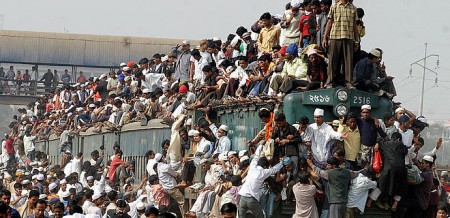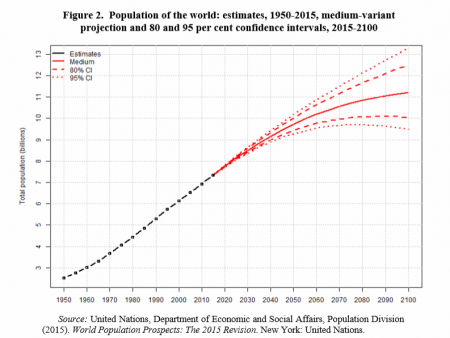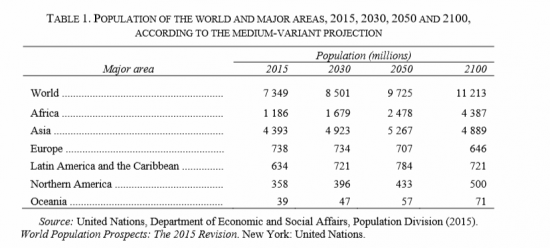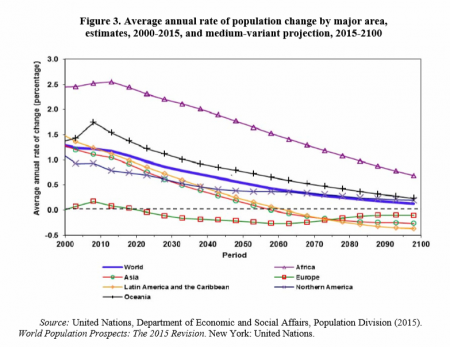August 14, 2015 – If you live in Canada it sometimes is hard to believe that our world will see an almost doubling of population between the beginning and end of the 21st century. That’s because the population growth being experienced globally is not reflected locally in this country. Instead it is happening largely in countries of the Developing World led by India, Nigeria, Pakistan, Congo, Ethiopia and others. Even the United States is contributing to world population growth and is named in the latest United Nations Department of Economic and Social Affairs report, World Population Prospects: The 2015 Revision, as one of the nine contributing the most to the global increase.
The two figures seen below come from the United Nations report. The figure at the top shows estimated ranges in world population growth from various models and plots the median growth (the sold red line). The second figure indicates from where the growth will come.
Of the ten most populous countries in our world today five are in Asia, two in Latin America, and one each in Africa, North America and Europe. Today the United States is the third most populous country on the planet only trailing China at number one and India at number two. But India at 1.31 billion today will by 2022 hit 1.4 billion, the same as China, and thereafter will grow to 1.7 billion by 2050. China on the other hand will have peaked by 2030 and begin to see a decrease.
The third figure in this posting shows the average rate of population change by geography. Note that rates of change will decline throughout the century but even then our human population will continue to grow.
And where will that growth be greatest? Nigeria, the seventh most populous country today is expected to surpass the United States in 2050 to become the third largest nation. And by the mid-century six countries are forecasted to have populations in excess of 300 million. That’s double the number today. Meanwhile the United Nations has identified 48 countries, 27 of them in Africa, all Developing Nations, that are expected to double in population from 954 million today to 1.9 billion in 2050. For these 48, the forecast is 3.2 billion by 2100. These are countries with their present population burden struggling with poverty, hunger and malnutrition. What will it be like for them in 2050 and 2100?
For the 48 Developing Nations mentioned in the previous paragraph there are 48 others who will see net decreases in population between today and 2050. Most of these are European states. Note that 2050 will be the nadir with a slight upswing throughout the remainder of the century.
Another global trend is human aging. The elderly represent the fastest growth segment with life expectancy rising in tandem. By 2050 34% of Europe’s population will be over the age of 60. Asia will see 25% and Africa 9%. Global life expectancy will rise from 70 today to 77 by 2050 and 83 by 2100. Africa which today has the lowest life expectancy, has already experienced a rise by 6 to age 60 during the first 15 years of this century. That trend is expected to continue with average lifespans in Africa rising to the high 70s by 2100.
Right now the world is largely dominated by a youthful population largely found in the Developing World. Children under the age of 15 make up 41% of Africa’s population. A further 19% are between the ages of 15 and 24. Significant numbers of young people can be found in Asia, Latin America, and the Caribbean. Of the 7.3 billion living now 2.8 billion fall within those two demographics.
Can the world sustain 11.2 billion people by 2100? Can the world sustain a large aging population? Can the world provide the health care, the education and the employment to all those both living today and tomorrow? What additional stresses will be put on world population by changing climate and rising sea levels? It would seem humanity is racing towards a perfect storm, a population bomb and a climate bomb.
A number of comments that I have received from readers in the past talk about a reckoning, a moment in time when draconian policies and measures will have to take place to mitigate these impending crises. Some have suggested enforcing sterilization in populations most affected rather than witness potential mass starvation.
The picture the United Nations is painting is not a pleasant one yet nowhere in the document does the world body describe the consequences of its forecast. That’s not to say that the United Nations isn’t addressing mitigation, adaptation and sustainability. Under the Department of Economic and Social Affairs it has hammered out a 193-nation agreement on sustainability that features 17 goals and 169 specific targets addressing environment, energy, technology, production, consumption, infrastructure, education, employment and more.
Related articles across the web





















